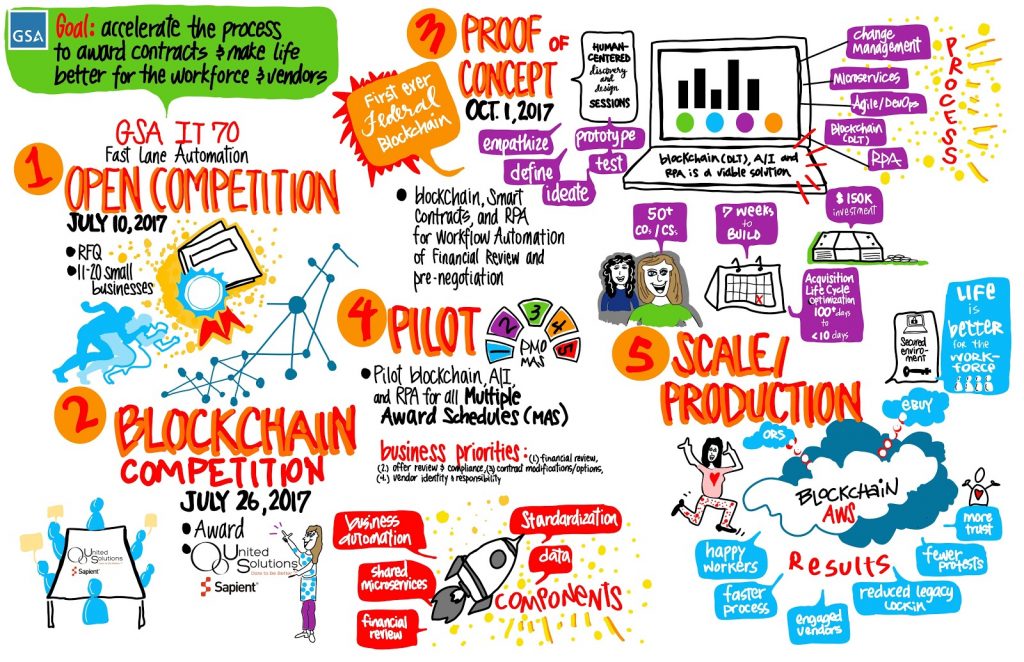Our mission in the Office of Information Technology Category (ITC) is to “maximize customer value and mission productivity through IT acquisition.” As the largest provider of IT acquisition solutions for government, it is absolutely critical that we ride the bleeding edge of IT innovation. As a service to agencies and taxpayers, we adopt innovative solutions early on and apply them to our own processes — we learn about new technologies by using them. Efforts like this position us to even more effectively help agencies face their future mission needs.
In a blog post last December, we announced our experimentation with distributed ledger technology (DLT) — commonly referred to as “blockchain.” At the time we had just completed a proof of concept to further enhance our Making it Easier FASt Lane proposal review process. We found that DLT can automate many of the manual business processes and steps required to award a new IT Schedule 70 contract. This includes time-intensive tasks such as financial reviews and development of pre-negotiation memoranda, freeing up our workforce to focus on more meaningful responsibilities. DLT also modernizes the award process making it easier, more efficient, and faster for those new contract holders.
IT modernization is a major focus of this administration. Our work with DLT is an excellent example of leveraging emerging technologies to enhance existing systems — to reimagine how we build using an agile methodology to effectively modernize over time. The crawl/walk/run method that we’re using to implement DLT highlights one best-practice path to modernization.
First, We Crawled – What We Did
In July 2017, we kicked off the proof of concept (POC) as an award under the simplified acquisition threshold. This acquisition strategy used an agile acquisition and development approach and had a short, six-week delivery schedule. The entire POC only cost $150,000.
Now We Walk – Development
The POC demonstrated how we could use DLT to help automate our acquisition workforce, specifically touching and entering data only once into a single solution.
To expand the project’s scope, this May we awarded a contract for a pilot. Where the POC tested the waters limited to IT Schedule 70, the pilot has a wider scope: the Multiple Award Schedules (MAS) program (aka the Schedules). We plan to look across the entire enterprise to find out where we’ll gain the most benefits within the Schedules program.
The pilot will create a DLT-based software layer over GSA’s existing infrastructure which creates transparency and documents activities between industry partners (contractors/vendors) and GSA.
This layer will make the proposal review process accountable and allow for a controlled reduction in fixed costs. Also, the pilot automates financial reviews and other GSA Schedules business processes.
For example, we can identify offerors with substandard financial ratios based on the average (as reported by the IRS) of their respective NAICs code. Offerors with poor financial ratios will be flagged for further review; if the ratios look good they will move to the next step.
This first pilot will break down and modularize the workstream and build out a micro-service for the financial responsibility process. Implementing a manageable business process, this will enable us to more simply capture information and to build analytics.
Next, We’ll Run – Production/Sustainment
If the pilot is successful, we’ll continue its development and our efforts to make this a reality by awarding another contract for a full-scale production.
Think IT Modernization? Think GSA
Our team has the expertise and agility to try new things and test new IT solutions. We launch, test, learn, and then use those lessons learned to support our customers.
So, when you think about modernizing your IT systems, think GSA! We have the experts and acquisition solutions in place to make IT modernization a reality for the federal government.
Please follow us on Twitter @GSA_ITC and LinkedIn to join our ongoing conversations about government IT.
